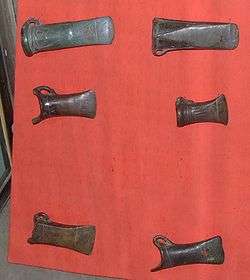Celt (tool)


In archaeology, a celt /ˈsɛlt/ is a long, thin, prehistoric, stone or bronze tool similar to an adze, a hoe or axe-like tool.
Etymology
The term "celt" came about from what was very probably a copyist's error in many medieval manuscript copies of Job 19:24 in the Latin Vulgate Bible, which became enshrined in the authoritative Sixto-Clementine printed edition of 1592; however the Codex Amiatinus, for example, does not contain the mistake.[1][2] While this is now considered to be the case by most scholars, some are still prepared to consider the existence of a real Latin word.
A "celt" was thus wrongly assumed to be a type of ancient chisel. Early eighteenth century antiquarians, such as Lorenz Beger, then adopted the word for the stone and bronze tools they were finding at prehistoric sites; the OED suggests that the imaginary etymological connection with the Celts may have assisted its passage into common use.
A shoe-last celt was a polished stone tool used during the early European Neolithic for felling trees and woodworking.
See also
References
- ↑ Laistner, M. L. W. (1 January 1925). "Floscvli Philoxenei [Flosculi Philoxenei]". The Classical Quarterly. 19 (3/4): 192–195. doi:10.1017/S0009838800015846. JSTOR 636281.
- ↑ ""Match 2" here". Archived from the original on 2011-07-17.